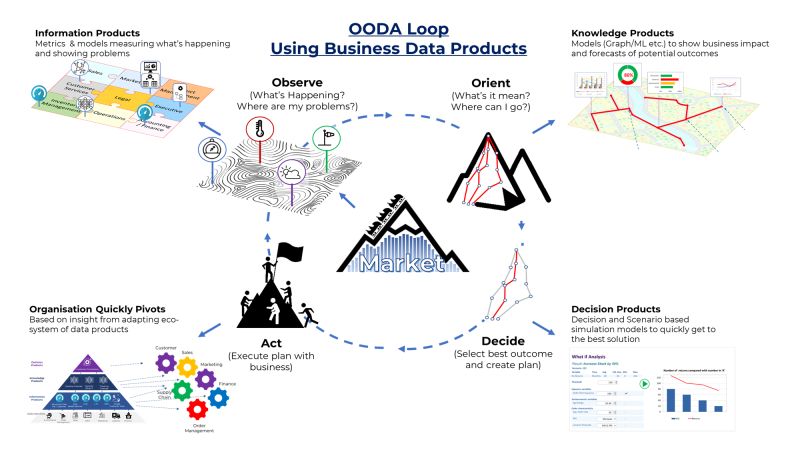Introduction
Organizations that can deploy business-focused data products using the OODA loop not only win but thrive in a bear market. This blog post expands on the ideas of data transformation as expeditions and building a business-as-usual (BAU) capability rather than relying on one-off big bang programs.
Below is a conceptual framework of what this could look like, using the OODA loop as the key structure.
The OODA Loop Framework
1. Observe:
To measure all critical points in your organization, along with market and customer factors, as fast as needed. This stage is akin to starting an expedition by measuring the weather, examining the terrain, and assessing costs and risks to determine the plan.
- Information Products: Quickly create metrics and models that measure critical business processes. These should be easily created by business teams and swiftly changed or retired as the business reacts to the market.
2. Orient:
Decide what routes to take by mapping out potential paths to the summit, considering risks, costs, feasibility, and value.
- Knowledge Products: Build machine learning forecasting models and graph analytics overlays to map out possible outcomes within the organization.
3. Decide:
Choose a candidate route based on planning, scenarios, and input from experience, measurement, and hypotheses, but be prepared for changes.
- Decision Products: Prototype simulation and decision science-based models in an "experiment and test" mode with goals such as reducing order return rates or increasing conversion rates. This enables business initiative plans to be assessed and re-crafted based on the outcomes.
- Business Strategy: Once outcomes are agreed upon, a business strategy is crafted.
4. Act:
The most important step is to execute the plan—set out on the expedition. Business execution is performed by various parts of the organization.
- Measuring Impact: Build information products to measure the impact of actions, which brings us back to step 1 in a continuous loop.

Building a BAU Capability for Expeditions
To achieve this as a BAU capability, expedition teams need to include:
- Map Readers: Business SMEs who understand the business.
- Guides: Data leaders who are business value-oriented and can guide the organization through the terrain.
- Expert Climbers/Orienteers: Data product specialists who can quickly create data product prototypes.
- Agile Data Visualization Experts: Specialists who can develop rapid data visualizations for fast feedback.
Expert Equipment: Data Infrastructure
Using data mesh and data fabric concepts, organizations need the following expert equipment:
- Quick Prototyping, Experimentation, and Iteration: Enable rapid creation and refinement of data products.
- Rapid Build of Data UX: Facilitate fast feedback using customer and real data.
- Simple and Quick DataOps, Data Engineering, and Automation: Deliver data products in hours or days, not weeks or months. Avoid complex data modeling, pipelines, and data ingestion processes.
Conclusion
Embracing the OODA loop framework and focusing on continuous, business-as-usual data capabilities rather than sporadic, large-scale projects can position organizations to thrive even in challenging market conditions. By assembling agile, well-equipped expedition teams and leveraging advanced data infrastructure, businesses can navigate the terrain of a bear market with agility and precision. This is what being data-driven truly means.

